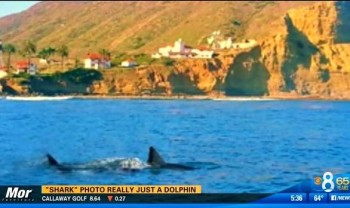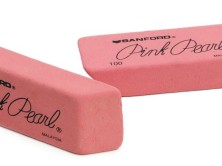
Above, see the fake photo.
So how did a fake shark image make it onto the TV news in a major U.S. city?
Last month, two San Diego news stations aired a fake photo purporting to show a great white shark swimming in local waters.
The actual, undoctored photo shows a dolphin, it turns out, but it had been Photoshopped to appear like a great white shark.
The fake image even fooled shark experts, one who warned, according to KGTV, “that San Diegans should be seeing more great white sharks like the one that was spotted by a kayaker off Point Loma just days ago.”
Back Story
The shark photo was originally sent to the 51-year-old Shark Research Committee.
A couple of days after the committee published the photo, the two news stations — KGTV and KFMB — both published reports on the image.
But whoops! Soon after the stories aired, the person who took the original photo of the dolphin contacted the Shark Research Committee and the two news stations to let them know the picture was faked.
Shark Research Committee received photo, tried to verify, and posted image
Ralph Collier, a shark expert and the president of the committee, told iMediaEthics that he received what he thought was a real photo of a shark in the local water, now revealed to be a doctored dolphin picture, from a friend who had gotten it from someone else.
The Shark Research Committee identifies itself as a “non-profit scientific research organization” that helps track “shark attacks from the Pacific Coast of North America” as well as researching “the general biology, behavior and ecology of sharks indigenous to waters off the Pacific Coast, with particular emphasis on potentially dangerous species.”
“My goal is to bring this information to people so they can make intelligent decisions about when and where to use the ocean,” Collier said to iMediaEthics.
Collier told iMediaEthics by phone that when he received the photo on April 20, he had been told that it was taken about a week earlier. A day later, he posted the photo on the center’s website along with a story about the shark he had received.
Two days later, he said the two stations, KGTV and KFMB, contacted him to ask about the photo for news stories. “I did not contact them,” he said.
“I’m not out for publicity after 50 years. That’s not what’s important to me,” he added. “What’s important is reporting accurate information.”
KGTV’s news director Joel Davis confirmed with iMediaEthics that the station first saw the shark photo on the committee’s website and then began looking into it for a story. He said that the station interviewed Collier as part of its verification and tried to find the original photographer for more information.
“We questioned [Collier] about the authenticity of the photo, and he felt very strongly that it was real. We tried different search engines to find the person who actually took the photo to get his story, but he has a very common name and we were unable to contact him. So, we ran the story with the context that it was posted by the Shark Research Committee website, and explained that they as experts believed it to be authentic.”
Collier said that after the news reports aired, a friend told him the photo may have been doctored. He later received a copy of the original photo showing the dolphin.
“You can see where an individual had a photograph of the white shark swimming at the surface and cut from the dorsal fin to the back fin off and placed it on top of the dolphin,” he explained.
“Had I known this was a fake, an altered picture, of course I would not have put it up,” he said, adding that he alerted the two media outlets when he found out the photo was not real.
KGTV’s Davis added that the original photographer contacted the station to let them know the photo was fake after seeing the news report.
Collier noted that the center doesn’t have any way to thoroughly vet submitted images for Photoshop. But, as part of his verification process, he talks to the people who submitted or took the photo. “I call, interview people,” he said. “You can tell after a while who’s trying to fake something and who isn’t.”
“This is the second time in 50 years that someone has tried this. I’m really not worried about this” happening again, he said.
Collier also maintained that “there was no mis-identification” when he and other colleagues identified the photo as a shark because the photo did show a real white shark, which was Photoshopped on top of the dolphin.
“If you look at the photograph, the dorsal fin and the tip of the caudal fin…is from a white shark,” he said. So, he said the photo does show a great white shark and the shark experts were correct as identifying the photo as such. But, they didn’t account for the reality that the shark was placed on top of a dolphin.
How News Outlets Responded
KGTV-10 left its original story up, April 23’s “Great white shark spotted off Point Loma,” but added an editor’s note admitting the station aired a fake photo.
The editor’s note stated:
“Editor’s note: After this story was published, 10News learned that the photo was in fact fake. It had been Photoshopped from a snapshot of a dolphin. Click here for more on this story.”
The editor’s note linked to KGTV-10’s follow-up story explaining the hoax.
In that story, KGTV interviewed Will Phillips, who took the dolphin photo and said his friend doctored it into a shark.
“The doctored photo began to circulate the Internet, Phillips said, and somehow made its way to the Shark Research Committee (SRC), which posted it on its website,” KGTV reported.
KGTV’s follow-up report also interviewed the Shark Research Committee’s Collier about the incident.
While KGTV left its report up, KFMB unpublished its original story, the April 23 report “Great white, great shot! Shark off Point Loma.”
A Google News search for “great white shark California” still showed KFMB’s story.
But, when you click the link to the story, you are taken to an error page.
KFMB did publish a follow-up story admitting it was duped and apologizing for the error. The follow-up story, “Shark Photo Really Just a Dolphin,” said: “Earlier this week, we showed you a photo supposedly showing a great white feeding in the water just off the tip of Point Loma.”
KFMB explained how it was tricked and confirmed “the un-doctored photo shows the creature is really just a dolphin.”
“Our apologies as well,” KFMB added.
iMediaEthics has written to KFMB to ask why it unpublished the report.
Effect of the Doctored Image
“The old adage, seeing is believing, is not true,” Shark Research Committee’s Collier lamented. “If you see it with your own eyes, yes, but it used to be if someone showed you a photograph,” you knew it was real. “You can’t do that today” because of altering technology.
“This is not from lack of experience what occurred,” he said. As a result of the fake photo, he said, “some of the public may not want to believe some of the things they see or hear an rightfully so after something like this.”
Except for the person who doctored the photo, he said, “no one in this case had any thoughts of trying to dupe the public or harm the public with this.”
“We were all simply reporting on what we believed was photographic evidence..that we believed was the truth,” Collier said.
KGTV’s Davis noted that the station had taken steps to verify the shark image before it reported on the photo.
“We are quite familiar with Internet photo hoaxes, which is why we approached this story the way we did,” Davis told iMediaEthics by e-mail. “We challenged a well known expert (Ralph Collier) about the authenticity, and he explained why he believed it to be real. If you look at the story that originally aired, our reporter starts by stating ‘When you see a photo like this, you have to be leery of a hoax.’ He then went on to detail that the Shark Research Committee expert believes it is authentic, and why.”
“Collier, who has a very reliable reputation, told us that sharks have frequented that area for years, and have recently been coming in closer to shore to feed on sea lions,” he added.
Davis said the station will “continue to run any such photos by experts” before publication and also pointed out that transparency is key whenever there is a problem in news reports.
“If somehow the expert(s) get fooled, we’ll be transparent about that,” he said. “I think viewers give a lot of credit to media who are transparent about the process they used for both the initial story, and the followup.”








Comments Terms and Conditions